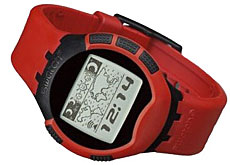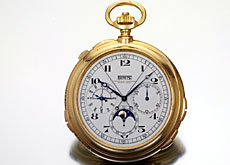A computer disguised as a watch

Sports results and financial updates will soon be within easy reach, thanks to the new “Paparazzi” watch jointly designed by Swatch and Microsoft.
But there is no danger of the traditional wristwatch being swept away by the rising tide of technological innovation.
“Right now, for example, I’m checking how Microsoft’s shares are doing,” said Bill Gates during the presentation of the novel timepiece in New York.
The American software king in fact mentioned only one of the features of the new watch produced by the Swatch Group in collaboration with MSN Direct, a division of Microsoft Corporation.
The Paparazzi Swatch looks like a conventional sports watch, but under the coloured plastic lurks a sophisticated microprocessor.
Weather and sports results
This miniature computer can tell you what the weather will be like tomorrow, what films are showing in local cinemas, your horoscope, the sports results and stock-exchange prices – as well as the time, of course.
“All you have to do is register on line with the MSN Direct service to receive, free of charge, the information package of your choice,” explains Carmen Daetwyler, head of public relations at Swatch.
The new model, which is currently being marketed only in the United States and Canada, with a price-tag of around SFr200 ($150), will not be on sale in Switzerland until the spring of 2005.
“Microsoft’s European distribution network is not yet ready,” explains Daetwyler. “Negotiations are still going on with retail chain owners.”
Wrist-top computer
The new Paparazzi is a further development of Microsoft’s Smart Watch, the so-called intelligent watch that gives a wireless connection to the internet.
From a straightforward timepiece, the conventional wristwatch is being transformed into a miniature computer, a development which – like that of other electronic gadgets (mobile phones, digital cameras) – seems limitless.
“We have many plans for the years ahead,” claims Daetwyler but, mindful that competitors have their ears to the ground, she is not prepared to be more forthcoming.
More willing to discuss future trends is the deputy curator of the international watch and clock museum, based at La Chaux-de-Fonds.
“There are two main lines of development: the watch as a decorative accessory, more or less expensive but basically traditional in appearance, and the watch designed to provide increasing amounts of information,” explains Jean-Michel Piguet.
Traditional versus modern
“However, the watch of the future will have to come to terms with the limited size of the dial,” observes Piguet, who does not exclude the use of peripherals.
“Maybe it will be possible to connect to a keyboard.”
“Nevertheless the traditional wristwatch has lost nothing of its appeal,” claims Roy Somazzi, a restorer at the Crono watch-and-clock workshop in Lugano.
“The major manufacturers will not touch ‘intelligent’ watches with a barge-pole. If you want a watch that is a thing of beauty, buy a mechanical one.”
The deputy director of the watch museum also points out that “when the first electronic watches appeared in the 1970s, people thought the writing was on the wall for traditional models”.
“But nothing was further from the truth. Despite the fact that quartz watches perform well and are cheap, watches with a traditional mechanism have not lost ground, far from it,” notes Piguet.
Healthy turnover
Where exports are concerned, statistics produced by the Federation of the Swiss Watch Industry say it all: in 2003, out of a total turnover of SFr10.1 billion, mechanical watches accounted for SFr5.87 billion (almost 60 per cent).
“The countries most devoted to mechanical models are those with a long watch and clock-making tradition, such as Italy,” observes Philippe Pegoraro.
The head of the federation’s information service also points out that alongside Switzerland’s more traditional markets – the United States, Japan, Germany, Italy and Britain – other countries are beginning to emerge as major buyers.
“China and Russia are increasingly significant,” reports Pegoraro.
Whereas in 2003 sales to the main European and Asian markets registered a slight decline on the previous year, demand from China continued to grow, actually doubling in volume.
swissinfo, Luigi Jorio
In the first nine months of 2004, the value of Switzerland’s clock and watch exports was SFr7.67 billion.
The figure for 2003 was SFr10.1 billion.
The new “Paparazzi” launched by Swatch and Microsoft is designed to receive information of various kinds in real time.
The new-generation electronic watches are unlikely to spell the end of traditional models, which are still very much appreciated for their engineering and good looks.
In future, Swiss exporters will be looking to the expanding Chinese and Russian markets, as well as long-standing clients in the United States, Japan and Europe.

In compliance with the JTI standards
More: SWI swissinfo.ch certified by the Journalism Trust Initiative











You can find an overview of ongoing debates with our journalists here . Please join us!
If you want to start a conversation about a topic raised in this article or want to report factual errors, email us at english@swissinfo.ch.